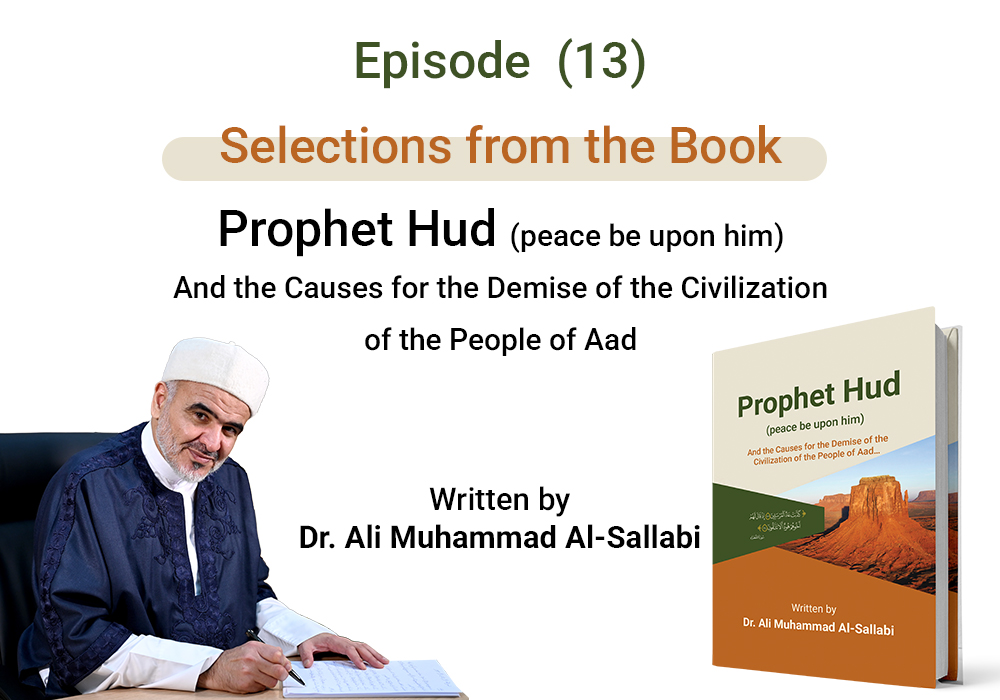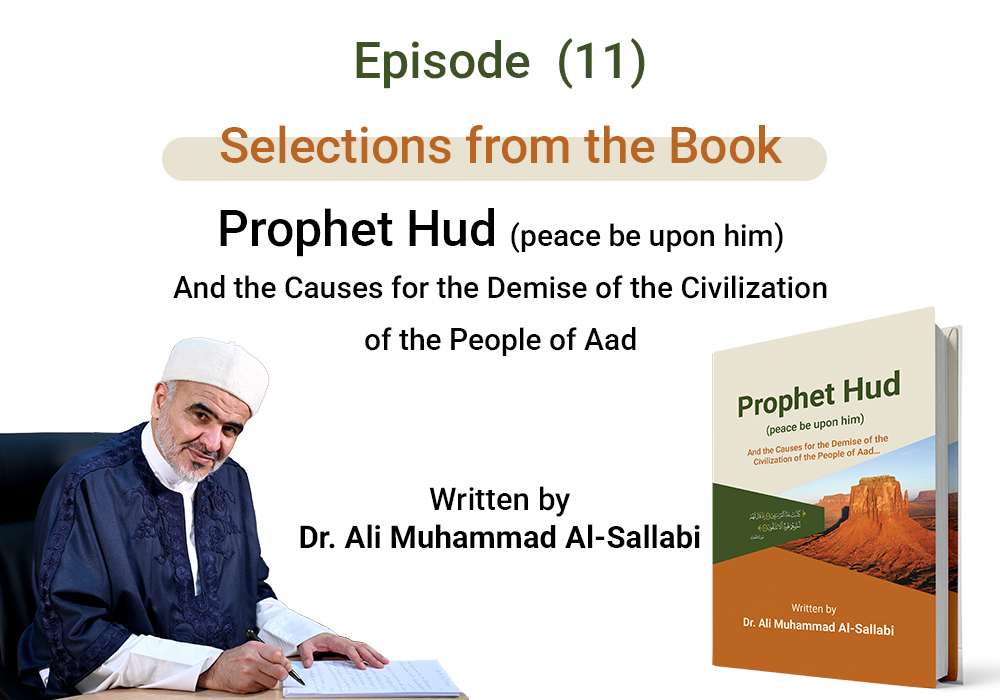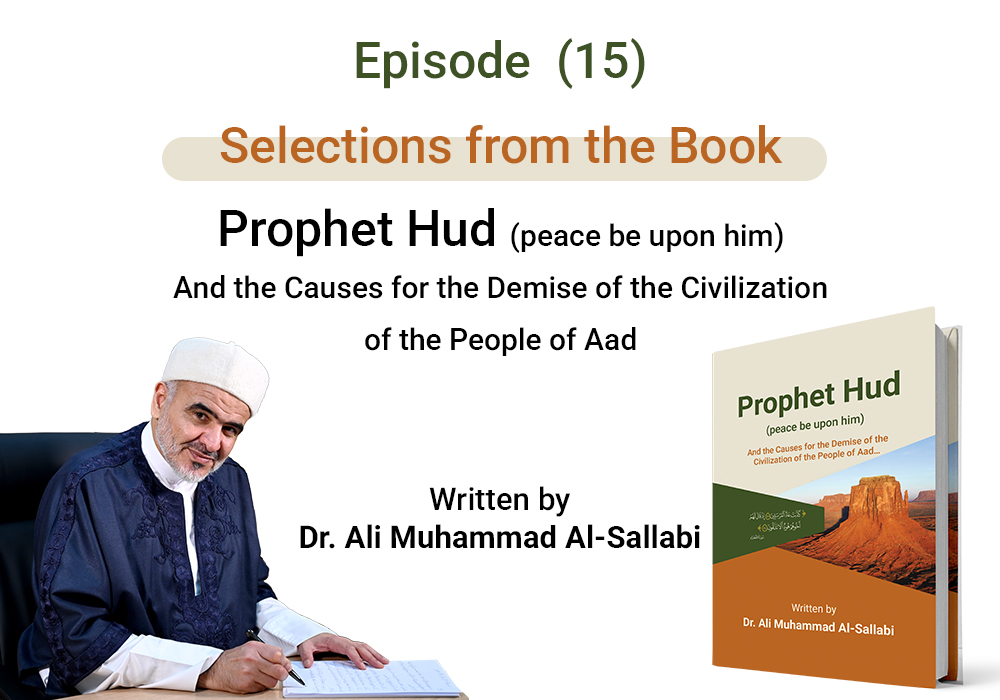The Second Aad
Selections from the Book Prophet Hud (peace be upon him) And the Causes for the Demise of the Civilization of the People of Aad…
Written by Dr. Ali Muhammad al-Sallabi...
Episode (13)
Allah Almighty said: {And that He destroyed the first [people of] ʿAad.} [An-Najm: 50]. He called those who perished from the people of Hud (peace be upon him) "the first Aad". So, everyone who disbelieved in Hud (peace be upon him) was struck by divine punishment {And they became so that nothing was seen [of them] except their dwellings.} [Al-Ahqaf: 25]. And His saying: {so you would see the people therein fallen as if they were hollow trunks of palm trees.} [Al-Haqqah: 7]. These are the ones who disbelieved and did not believe. As for those who believed in Hud (peace be upon him), they are the second Aad, the ones whom Hud led to settle the land on the foundation of monotheism and the exclusive worship of Allah Almighty, according to some historians, including the scholar Suleiman Nadwi. He supported his view with the following verse: {So We saved him and those with him by mercy from Us. And We eliminated those who denied Our signs,} [Al-A'raf: 72]. And His saying: {And when Our command came, We saved Hud and those who believed with him, by mercy from Us; and We saved them from a harsh punishment.} [Hud: 58].
It is reported in the stories of the Arabs that they left the dwellings of Aad before the punishment came and reached the Hejaz, where a king named Luqman arose among them. It is said that he lived for several centuries. This is not strange, as the history of most ancient nations and peoples begins with such long-lived kings, and it is now interpreted that the kingdom remained within his family for several centuries, and his name was metaphorically used. Therefore, what we should understand by the long life of Luqman is the long life of his family.
A stone inscription of Aad was found in 1834, in which it was written: "We are ruled by kings who are far removed from evil thoughts and punish the unjust; they were created for us according to the law of Hud, and just cases were written in a record". This is the first Arabic inscription discovered by Europe in the lands of the Arabs. The language and script of this inscription are in the South Arabian script (Musnad), which later generations called the Himyarite language, and it is now known by this name. The Himyarite text of the inscription is on a separate page, and its translation is as follows:
- We have enjoyed the display of this palace for some time, and we lived a life of prosperity without hardship or distress.
- The waters of the seas overflowed into our rivers, and the seas clashed with their waves against the walls of our fortresses in anger, and our springs flowed with strange sounds.
- Above the towering palm trees, whose farmers planted their dates in our valleys, and they grew rice.
- We used to hunt sheep and young rabbits with nets, and we fished. We adorned ourselves in colorful silk garments, in satin and green dresses, and we were ruled by kings far from shame, who punished the wicked and established for us the law of Hud.
- Just cases were recorded in a book, and we believed in the signs and in resurrection and revival.
- Enemies came to us, intending to fight us, so we advanced with our friends, and the noble youths advanced with their well-armed black horses.
- The proud and brave among our men and women fought on the gray horses, the brown, and the red, with their riders mounted.
- Our swords struck our enemies and pierced them until we reached their hearts, defeating them, for they were the worst of creation.
Archaeological discoveries are still ongoing in this vast world, and in Yemen, Hadramawt, Hijaz, Al-Hijr, Al-Ula, Al-Mada'in, Auran, Palmyra, As-Safa, Iraq, and Egypt, there are many remains of ancient Arabs, their palaces, and memories. Thousands of tablets and inscriptions have been found, from which archaeologists have made remarkable deductions. Most of these inscriptions are written in Himyarite, Sabaean, Aramaic, and Nabataean scripts. These archaeological findings were studied during the Umayyad and early Abbasid periods, when Muslims had reached the peak of their scholarly endeavors in the field of history. Scholars of that era were familiar with most of these scripts and languages. For instance, Dhul-Nun al-Misri, in the 2nd century Hijri, was able to read Egyptian hieroglyphs. The famous Himyarite scholar, al-Hamdani, described these famous artifacts in his books Description of the Arabian Peninsula and Al-Ikleel.
These writings and artifacts not only shed light on some aspects of the later Aad but also support what the Holy Qur'an mentions in various ways:
- That Hud (peace be upon him) was a historical figure.
- That the remains of Aad were nothing but the followers of Hud.
- That Aad had tall structures and lofty buildings.
- That Aad had gardens, rivers, children, and numerous livestock, as stated in the Holy Qur'an: {Provided you with grazing livestock and children (133) And gardens and springs. (134)} [Ash-Shu'ara: 133-134].
The name of the later Aad appears in Greek history and Greek geography in the northern and eastern parts of Madian, and it was called Adait in Greek pronunciation. Muslims were also aware of this settlement of Aad, and its existence in Yemen, as confirmed by general Arab tradition, is also supported by Greek geography. Ptolemy mentioned that among the tribes of southern Arabia were Aad Rimita and Adait. The first name is translated as Aad of Iram, and the second as Aad. Ptolemy, who lived in the 2nd century CE, affirmed the existence of Aad in that era.
- Ali Muhammad al-Sallabi, Prophet Hud (peace be upon him) And the Causes for the Demise of the Civilization of the People of Aad, pp. 216-220.
- History of the Land of the Qur’an, p. 188.
For further information and review of the sources for the article, see:
The Book of Prophet Hud (peace be upon him) And the Causes for the Demise of the Civilization of the People of Aad on the official website of Sheikh Dr. Ali Muhammad al-Sallabi:






